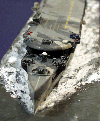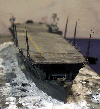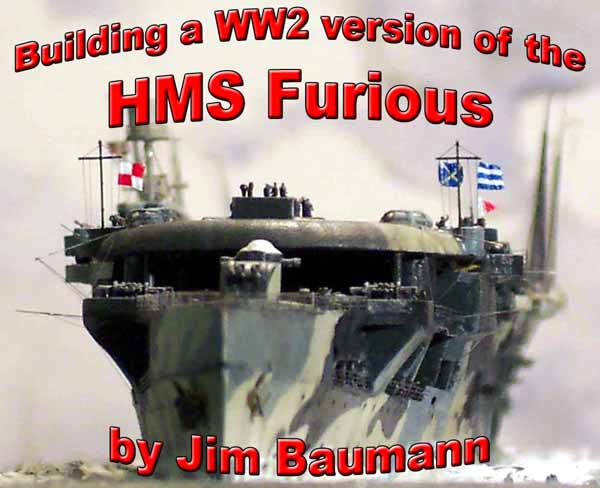 |
||||||||||||||||
| HMS FURIOUS the carrier was converted from the Battlecruiser
of that name, advancing in various guises to finally having a flying on-deck
bisected in the center by a funnel and bridge structure as well as a flying
off deck forward!! She served in two World wars with distinction and was
by far the hardest worked carrier in the Royal Navy. After WW1 she was
entirely re-constructed into a 'flat-top' emerging on 1 September 1925
a dramatically different looking ship.
She served the inter-war years without incident, being continually upgraded with new weaponry and aircraft in two major re-fits. Re-commissioned 1939 she had been fitted with a small island and HA/LA 4"guns, the forward flying off deck was now an AA platform sitting atop a raised bow with the fwd hangar doors being plated up. She served in the early years of WW2 hunting enemy surface shipping and ferrying aircraft as well as lending extensive air support to the Norwegian campaign. She refitted in Philadelphia USA in 1942. She assisted in keeping Malta supplied with aircraft, as part of Force H gave aircover for operation Torch landings in North Africa . Thereafter she assisted in covering the North Russian convoys before finding herself again in Norwegian waters launching damaging air attacks on the German battleship Tirpitz as well as sinking much enemy shipping with her aircraft. After 27 years of strenuous service she was deemed in August 1944 to be thoroughly worn out. She served her last years in commission in ship target trials, b sold for breaking up in 1948, this being finally completed in 1954. |
||||||||||||||||
| ----- When wishing to build a model of HMS FURIOUS in her
post 1925 rebuild to WW2 configuration in 1/700 one is faced with three
choices:
2) Purchase the HP Models kit and engage in resin butchery and build it to the best of your ability.... 3) Purchase a set of plans from the National Maritime Museum in London and scratchbuild the entire thing!! This is the tale of option 2.... Upon opening the box I was initially thrilled with the contents-- a brief dry fit however soon showed all was not entirely well.... There were a number of gaps, chunky platforms and some plain inaccuracies none of which were particularly troublesome to a moderately experienced modeller. I have always visualized Furious in WW2 as being quite low and sleek ... the above dry fit immediately struck me as being very tall and lofty....checking photos and measuring with dividers, seeking opinion on message boards, guessing and wondering soon had me in a quandary. I was fortunate to have been loaned a set of NMM plans --this established after a session armed with paper and calculator that the assembled kit would be between 2.2 and 2.3mm to tall, this in itself is not a vast measurement, in a 1/700 carrier it upset the visual balance of the model! I was determined to have a WW2 Furious!... so here is how I went about it! First of all I established that the lower hull casting was dimensionally fundamentally OK, the main problems lay with the deck thickness and the hangar side heights and proportions of the 'cutouts'. |
||||||||||||||||
| I used dividers, pencil and Tamiya Masking tape to mark off where the material was to be removed. | click images
to enlarge |
|||||||||||||||
 |
||||||||||||||||
| This was achieved using my trusty belt sander (as ever, used at night!) |  |
|||||||||||||||
 |
||||||||||||||||
Other recesses were achieved with saw cuts and the use
of a Stanley blade as a chisel along with some hefty blows of a hammer.
This gave a very crisp straight cut edge to the resin, proportions of cutout
heights and steps being adjusted with styrene strip.
|
||||||||||||||||
Another manufacturing shortcut in the hull casting I wanted
to cure was the forward deck undercut. On the real ship this was the capstan
deck and the overhead deck was held up by struts with gusset plating for
rigidity. On the kit hull it was relief rendered only... this called for
sawing, grinding and some delicate work with brass and styrene.
|
||||||||||||||||
| I made some capstans from Model railroad brass bits , styrene
chainways and brass chain.
In amongst this surgery the commendably thin resin bulwarks had collapsed and were replaced with styrene items, this time angled correctly to the outward slope of the superstructure. Further fwd I made them of paper. |
 |
|||||||||||||||
 |
||||||||||||||||
 |
||||||||||||||||
| Close scrutiny of the NMM plans (bearing in mind the numerous refits and changes to the ship since the plans were drawn) showed the flightdeck to be too short. I lengthened the casting at the appropriate point using styrene shims . I also sanded the deck extensively in thickness as well as plan profile to give the distinctive humpback shape. |  |
|||||||||||||||
| In the above operation I intentionally removed the AA tubs (too clunky, wrong shape and wrong place) and un-intentionally the neat representation of the holes all along the flight deck edge Close examination of photos showed these to even more frequent than the removed items. I did not however relish drilling all those holes perfectly... so I cheated! Using some GMM canvas dodger railing PE cut in half with scissors did the trick nicely. I cut and joined the strips underneath the guntubs so as to prevent later buckling with expansion and contraction problems caused by temperature variations. |  |
|||||||||||||||
| HMS Furious was initially rebuilt without any kind of Island structure, conning of the ship being carried out from two 'pods' port and stb of the forward edge of the flightdeck as well a retractable navigation 'bridge' in the forward center position of the flightdeck . The latter was built from styrene and stainless steel PE scrap. The port and starboard conning tops were given a domed roof of white glue and windscreens of PE handrail. |  |
|||||||||||||||
The funnel and exhaust arrangements of the ship were unique.
I wanted to represent the funnel tubes behind their cooling 'egg boxing'.
In the kit it was anticipated that this recessed space would be painted
black--photos of HMS Furious show the exhaust trunking to be visible behind
the egg boxing. . This I feel really should have been a PE piece-- it would
have rendered that area so simple and crisp! --alas I arduously and very
carefully ground out all the resin behind the 'egg boxing', until such
time only thin wafers were left between the uprights and horizontals; these
were pushed out and the grating cleaned up with knife blades. I installed
the tubes as a representation of the exhaust funnel trunking.
|
||||||||||||||||
| She possessed large exhaust vents on either side of the aft flightdeck;
these of course impeded any kind of landing on.... So the smoke was exhausted
out of the aft lower quarters of the ship when flying operations took place,
the changeover being made via flaps in the ducting . This operation was
referred to as 'smoking up / smoking down! An unwanted side effect of 'smoking
down' was that exhausted sooty deposits soon made the aft end of the ship
unsightly- the counter-measure was to simply paint the aft section of the
ship black!
The lower exhaust ports were made of scrap PE and styrene strip. |
 |
|||||||||||||||
| The Port side of the camouflage in this scheme is very poorly documented- after an appeal on the message board I was soon sent this excellent photo! Thanks Miles! |  |
|||||||||||||||
| Having removed all AA gun-tubs new items were fashioned from brass PE scrap, a crisper medium than styrene strip. |  |
|||||||||||||||
 |
||||||||||||||||
| The braces fitted to the undersides were cut down from the WEM Ark Royal radio mast PE parts This fret was used extensively for all the wrong applications! |  |
|||||||||||||||
| Further work carried out on the hull sides involved replacing most boat platforms and fitting these with braces, cut from 1:200 ladderstock, as well as fitting the flightdeck drains made of styrene strip. |  |
|||||||||||||||
| Infuriatingly I noticed at a late stage of construction that the apertures in the panel below the Island were hopelessly incorrect in appearance, as well as not being pierced through tom the hollow behind. | 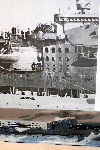 |
|||||||||||||||
| I had to cure this fairly minor feature, the grinder quickly made a recess leaving an uneven surface. This was lined with a piece of brass. |  |
|||||||||||||||
| I made the new aperture panel from thin styrene, cut and drilled the holes , in my view a vast improvement... the process was repeated on the port side. |  |
|||||||||||||||
| The 4" HA/LA mounts were the kit items correctly supplied with the larger shield, these were fitted with the fire arc limiting rails, these can just be discerned in some photos of the real ship, a feature rarely modelled in small scales. |  |
|||||||||||||||
| The Flight deck surrounding catwalk 'floors' can look heavy in 1/700 , I used GMM Goldplus destroyer netting; whilst this is not exactly correct it does succeed in giving a very lightweight and airy final appearance when fitted with the handrails separately. | ||||||||||||||||
| The davits for the shipsboats in the 'hollows' were made of two different sizes of styrene strip after the boats were in place, |  |
|||||||||||||||
| The boat cradles were made one-sided of paper, glued in place with CA and the boat was slid in sideways. |  |
|||||||||||||||
| Unfortunately not a single kit supplied boat could be used
as they were all generic rowboats. These were all replaced with WEM Pro
items.
I partially recorded the sequence of placing the ship in her sea. All my 1/700 models reside in wall cases. which all have timber framed shelves of uniform width -this allows interchangability of models within all cases |
 |
|||||||||||||||
| The ship was supported on padded supports on her flightdeck upside down. The 3 mm stainless steel plate had been pre drilled with countersunk holes so as to allow the resin hull to be screwed down to eliminate any later warping or hogging. The wave pattern had been created using cocktail sticks, the embossed artists watercolor paper earlier had the hull shape cut out fractionally larger than the waterline footprint. This was affixed to the plate using double sided tape giving an instant fix. I first separated the well used timber 'build handle' and placed the model onto its base having first pulled the 'water paper' up around the models 'waist'. |  |
|||||||||||||||
 |
||||||||||||||||
| The model was then screwed down using the pre drilled and tapped holes using stainless steel screws. Unfortunately one of the holes was to close to the stern, possibly the hole had not been drilled deep enough ; while giving the screw its 'final' half turn the stern neatly cracked off!!! | 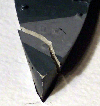 |
|||||||||||||||
| I neatly re-glued the stern(!) repainted the area and vowed next time to have more holes in the plate to give more choice in screw placement! The watercolor paper was then soaked in CA to make it moisture proof and hard. |  |
|||||||||||||||
| While at the stern I elected to make the cranes at the aft hangar entrance. These are unusual in being square in shape so as to allow their stow position under the flightdeck, the kit items being solid resin and hence of no use I manufactured two cranes cobbled together from GMM Carrier PE and handrail |  |
|||||||||||||||
 |
||||||||||||||||
| The model was painted using WEM and Humbrol enamel paints weathered with watercolor. The sea color chosen was a dark grey mixed with just a hint of green, so as to portray the cold waters off the coast of Norway. I extensively used toothpaste to back fill gaps and create translucent wave crests made with a flat spade brush to complement the spindrift and spray made of torn tissue paper. |  |
|||||||||||||||
| The pompoms used were WEM resin items dressed up with PE as the kit items were way too large. The cast anchors were removed and replaced with WEM PE items. The large homing beacon was made of aluminum tube on a disc of PE furnished with handrails. from GMM Goldplus as were all the remainder of rails fitted to the ship. | ||||||||||||||||
| The large radio aerial masts were made using a combination of GMM and WEM items topped with wire 'hockeystick ends' . The GMM PE masts were 3 sided only, the 'open box' was supplied with a lid from the WEM set. These were rigged with stretched sprue. The radio aerials are portrayed in an upright position as no flying operations are taking place. Most photos of Furious underway show an empty deck, RN carriers of that era had no aircraft deck park. This fact contributed to the loss of her half sister HMS Glorious, but that is another story and another model! |  |
|||||||||||||||
|
||||||||||||||||
| In conclusion ....
HP models must be commended for having made an excellent choice of a great and esoteric subject that fills a gap in any RN carrier collection. Unfortunately the elation was marred by the kit being disappointing considering its high price- many things could have been so very much better, accurate and more satisfactory with only a little more effort. The use of PE for some of the structure would have made the result so much crisper in final appearance My thanks have to go out to all my 'virtual' message board model friends around the world who rallied to my aid with photos, help, drawings and plans main References used :
|
||||||||||||||||




















